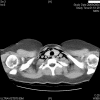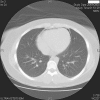Ecstasy-associated pneumomediastinum
- PMID: 17535617
- PMCID: PMC1963563
- DOI: 10.1308/003588407X183373
Ecstasy-associated pneumomediastinum
Abstract
Introduction: Ecstasy, also known as MDMA (3,4, methylenedioxymethamphetamine), is a popular illicit party drug amongst young adults. The drug induces a state of euphoria secondary to its stimulant activity in the central nervous system.
Patients and methods: A database review at two major inner city hospitals was undertaken to identify patients presenting with pneumomediastinum and their charts reviewed. A Medline review of all reported cases of pneumomediastinum associated with ecstasy abuse was undertaken.
Results: A total of 56 patients presenting with pneumomediastinum were identified over a 5-year period. Review of the charts revealed a history of ecstasy use in the hours prior to presentation in six of these patients, representing the largest series reported to date.
Conclusions: Review of previously reported cases reveals the likely mechanism is due to Valsalva manoeuvre during periods of extreme physical exertion, and not a direct pharmacological effect of the drug.
Figures
References
Publication types
MeSH terms
Substances
LinkOut - more resources
Full Text Sources
Medical



